荔枝和龙眼为典型的亚热带果树,主要分布在南纬18°~北纬24°海拔1200 m以下地区。我国是荔枝和龙眼的主产区,种植面积分别占世界总种植面积的72.5%和73.4%,年产量分别占世界年产量的61.1%和61.9%,在农业经济中占有重要地位[1]。近年来,广东省广州、揭阳、惠州、茂名、湛江和阳江等市区的荔枝、龙眼上粗胫翠尺蛾(Thalassodes immissaria Walker)逐步上升为主要害虫,发生量大,危害严重,一般果园枝梢被害率为30%~50%,危害严重的果园超过90%,有些枝梢甚至全被吃光,仅留下秃枝,严重影响荔枝、龙眼结果母枝的营养积累[2]。
目前,国内关于粗胫翠尺蛾的研究报道主要集中在形态学、生物学、寄主选择和综合防治等方面[1-5]。前期田间调查发现,粗胫翠尺蛾在荔枝、龙眼各主产区危害程度存在明显差异,在高海拔、高纬度的晚熟荔枝、龙眼产区发生相对偏轻,笔者推测温度对其发生程度有重要影响,但目前仅见陈炳旭等[1]报道了26 ℃温度对粗胫翠尺蛾各虫态发育历期的影响。昆虫属于变温动物,气候变暖会影响其种群田间始见期、种群高峰期以及发生范围等[6]。目前,我国是全球气候变暖最显著的国家之一,通过明确粗胫翠尺蛾的发育起点温度、有效积温以及最适温度等,不仅有助于分析未来气候变化背景下粗胫翠尺蛾的灾变规律,还可为预测预报及防控措施的优化提供依据[7-9]。然而,目前未见温度对粗胫翠尺蛾生长发育和繁殖影响的系统研究。
鉴于此,笔者在本研究中测定了20、23、26、29、32 ℃下粗胫翠尺蛾各虫态的发育历期、各发育期存活率及成虫繁殖力,并组建了粗胫翠尺蛾试验种群生命表,对其发育速率与温度进行回归分析,采用直接回归法和直接最优法2种方法计算发育起点温度和有效积温,构建发育历期的预测模型,以期为该虫种群的预测预报和管理提供参考资料。
1 材料和方法
1.1 材料
供试虫源:粗胫翠尺蛾采自广东省农业科学院白云试验基地荔枝龙眼园,在广东省农业科学院植物保护研究所人工气候室内用荔枝嫩叶稳定续代饲养8代以上。饲养条件为:(26±1)℃、RH(75±5)%,光周期14L∶10D。选取同批次健康、活力好的雌雄成虫,放入养虫盒(长×宽×高=25 cm×14 cm×11 cm)内交尾,养虫盒底部放置初展叶荔枝嫩梢供产卵,收集新鲜卵粒备用。
仪器:RXZ 智能型人工气候箱(宁波江南仪器厂生产),YC-D 202型亚都超声波加湿器(北京亚都科技有限公司)。
1.2 试验方法
1.2.1 不同温度下粗胫翠尺蛾发育适合度的测定 挑选饱满的粗胫翠尺蛾初产卵放入塑料养虫盒(长×宽×高=15 cm×11 cm×7 cm)中,分别置于温度为20、23、26、29、32℃,RH(75±5)%,光周期14L∶10D的人工气候箱中饲养,每个温度处理40粒卵,3次重复。卵期每天09:00定时观察1次,记录卵孵化情况及孵化历期。待卵孵化后,计数并将同一时间孵化的幼虫分盒饲养并标记,饲以妃子笑荔枝嫩梢,4 日龄后单头饲养。每天09:00 定时观察记录各温度条件下粗胫翠尺蛾幼虫的蜕皮情况,蜕皮后用镊子移除头壳记为2 龄幼虫,以此类推,直至幼虫化蛹。观察记录的同时更换新鲜荔枝嫩梢1~2 次,用湿润的脱脂棉包裹嫩梢基部保湿,清理养虫盒内的排泄物。幼虫化蛹后,将蛹放置于养虫盒内(长×宽×高=25 cm×14 cm×11 cm)。成虫羽化当天,将成虫按照雌雄1∶1 的比例群体饲养交配,次日起将雌虫分盒单独饲养,养虫盒底部放置浸润10%蜂蜜水的脱脂棉团作为食物来源,放置初展叶荔枝嫩梢作为产卵介质,嫩梢基部用湿润棉花包裹保湿,每天09:00定时更换1次嫩梢,并记录雌虫产卵量和雌雄虫存活情况,直至所有成虫死亡(雄成虫死亡后及时补充)。基于生命表试验可能出现试验虫雌雄成虫性别比例偏离1∶1的情况,在生命表试验开始时,各处理另取40 粒卵,在各温度条件下孵化和饲养,用于补充生命表试验配对。
1.2.2 不同温度下粗胫翠尺蛾试验种群年龄-阶段两性生命表的构建 根据年龄-阶段两性生命表理论统计原始数据,记录不同温度下粗胫翠尺蛾各发育阶段的发育历期、存活率、化蛹率、羽化率、成虫寿命、产卵量等数据。参照Chi等[10]以及葛繁星等[11]的方法,组建粗胫翠尺蛾试验种群两性生命表。其中,种群年龄-特征存活率(lx)指种群从初孵卵开始发育到年龄x 的存活率![]() (k 为粗胫翠尺蛾龄期总数,j为发育阶段,sxj为个体从初孵卵发育到年龄x阶段j的概率);种群年龄-特征繁殖力(mx)指整个种群在年龄x 的平均产卵数量
(k 为粗胫翠尺蛾龄期总数,j为发育阶段,sxj为个体从初孵卵发育到年龄x阶段j的概率);种群年龄-特征繁殖力(mx)指整个种群在年龄x 的平均产卵数量![]() 指雌性成虫个体在年龄x 阶段j 的产卵数量。通过试验种群生命表资料,可以获得粗胫翠尺蛾种群在特定年龄阶段的死亡率和出生率,进而估算其在不同温度处理下的种群动态参数:净增值率(R0)指个体一生所产的总后代数
指雌性成虫个体在年龄x 阶段j 的产卵数量。通过试验种群生命表资料,可以获得粗胫翠尺蛾种群在特定年龄阶段的死亡率和出生率,进而估算其在不同温度处理下的种群动态参数:净增值率(R0)指个体一生所产的总后代数![]() ;内禀增长率(r)指在环境适宜、食物充足、排除不利条件下种群最大的增长能力,
;内禀增长率(r)指在环境适宜、食物充足、排除不利条件下种群最大的增长能力,![]() ;平均世代周期(T)指一个种群达到稳定年龄-阶段分布和稳定增长速度时,增加R0所需要的时间,T=(lnR0)/r;周限增长率(λ)指一定时间期限内的总增长率,λ=er ;种群倍增时间Dt=(ln 2)/r。
;平均世代周期(T)指一个种群达到稳定年龄-阶段分布和稳定增长速度时,增加R0所需要的时间,T=(lnR0)/r;周限增长率(λ)指一定时间期限内的总增长率,λ=er ;种群倍增时间Dt=(ln 2)/r。
1.2.3 不同虫态发育速率与温度关系的预测模拟将不同温度下粗胫翠尺蛾各虫态发育历期进行加权平均,计算各虫态的平均发育历期,并将其转化为相应温度下的平均发育速率V(V=1/N),而后分别运用直线回归模型和二次回归模型进行回归分析,拟合粗胫翠尺蛾各发育阶段发育速率与温度的关系,通过相关系数R2和F值分别在0.05和0.01水平上显示各回归模型下发育速率与温度这两个因素的差异显著性,并以此为依据筛选出最优的拟合模型。
1.2.4 发育起点温度和有效积温的计算 发育起点温度C 和有效积温K 的计算采用直线回归法[12-13]和直接最优法[14]。
直线回归法计算公式为:
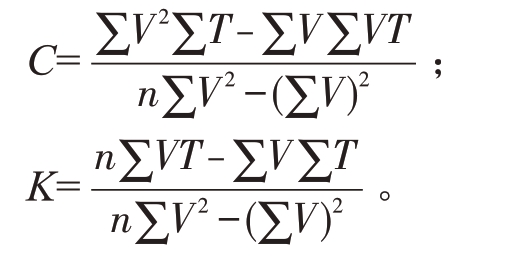
直接最优法计算公式为:

式中:V 为发育速率,T 为试验温度,n 为处理数,n=5。D 为发育历期,i 为温度处理,Ti为试验所设定的温度,Di为Ti温度条件下的发育历期(d)。
1.3 数据分析
采用Excel 和SPSS 23.0 对数据进行统计分析。对不同温度下粗胫翠尺蛾各发育阶段的发育历期和繁殖力等参数用Duncan’s 新复极差法进行单因素方差分析(ANOVA)。生命表参数的平均值和标准误采用Bootstrap方法进行估计推断。运用Origin8.5软件制作粗胫翠尺蛾存活率和繁殖率等曲线图,以及发育速率与温度关系图。
2 结果与分析
2.1 不同温度下粗胫翠尺蛾各虫态发育历期及繁殖力
如表1所示,在20~32 ℃范围内,荔枝粗胫翠尺蛾各虫态均能完成发育,且发育历期随着温度的升高逐渐缩短。20、23 ℃处理的粗胫翠尺蛾卵历期[分别为(3.62±0.13)、(3.58±0.06)d]显著长于26、29、32 ℃[分别为(3.01±0.16)、(2.51±0.19)、(2.29±0.24)d]处理(p<0.05);20、23 ℃处理的幼虫历期[分别为(23.39±1.81)、(20.23±1.26)d]显著长于29、32 ℃[分别为(14.28±1.51)、(12.48±0.95)d]处理(p<0.05);20、23 ℃处理的蛹历期[分别为(11.23±0.99)、(9.86±0.32)d]亦显著长于26、29、32 ℃[分别为(7.05±0.58)、(6.33±0.14)、(6.10±0.59)d]处理(p<0.05);20 ℃处理的预蛹历期(3.71±0.12 d)显著长于其他温度处理(p<0.05)。
表1 不同温度下粗胫翠尺蛾成虫前各阶段发育历期
Table 1 Developmental duration of each stage before adult of T.immissaria at different temperatures d

注:表中数据为(平均值±标准误),同列数据后不同小写字母表示经Duncan 氏新复极差法检验在p<0.05 水平差异显著。下同。
Note: Data present as (mean±SE),and different small letters in the same column indicate significant difference at p<0.05 by Duncan’s multiple range test.The same below.
温度Temperature/℃卵预蛹Prepupa蛹幼虫Larva 1龄1st instar 3.61±0.09 a 2.79±0.21 b 2.17±0.07 c 2.00±0.21 c 1.86±0.15 c 2龄2nd instar 3.34±0.15 a 3.17±0.05 a 2.50±0.09 b 2.28±0.18 b 2.13±0.11 b 3龄3rd instar 5.05±0.41 a 4.61±0.17 ab 3.48±0.20 bc 2.80±0.40 c 2.40±0.12 c 4龄4th instar 5.10±0.67 a 4.58±0.40 ab 3.59±0.16 bc 3.13±0.23 bc 2.71±0.17 c 5龄5th instar 6.29±0.47 a 5.08±0.41 ab 4.69±0.59 ab 4.07±0.48 b 3.38±0.40 b Pupa 11.23±0.99 a 9.86±0.32 a 7.05±0.58 b 6.33±0.14 b 6.10±0.59 b 20 23 26 29 32 Egg 3.62±0.13 a 3.58±0.06 a 3.01±0.16 b 2.51±0.19 bc 2.29±0.24 c 3.71±0.12 a 2.40±0.06 b 2.24±0.05 b 1.62±0.17 c 1.34±0.22 c
不同温度处理下粗胫翠尺蛾成虫寿命和繁殖力如表2 所示。20、23 ℃处理的雌成虫寿命[分别为(20.60±3.21)、(21.14±2.31)d]显著长于29、32 ℃[分别为(12.06±2.11)、(10.00±1.69)d]处理(p<0.05);各温度处理的成虫产卵前期[(2.11±0.16)d~(3.05±0.57)d]相当,没有显著差异(p>0.05);32 ℃处理的单雌平均产卵量(125.20±29.38粒)、雄虫寿命(8.50±1.75 d)均显著低于其他温度处理(p<0.05)。
表2 不同温度下粗胫翠尺蛾成虫寿命和雌虫繁殖力
Table 2 Adult longevity and reproduction of T.immissaria at different temperatures

温度Temperature/℃20 23 26 29 32雌虫寿命Female adult longevity/d 20.60±3.21 a 21.14±2.31 a 16.30±2.06 ab 12.06±2.11 b 10.00±1.69 b雄虫寿命Male adult longevity/d 17.52±1.35 a 17.88±2.65 a 15.36±0.89 a 12.67±2.63 a 8.50±1.75 b成虫产卵前期Adult preoviposition period/d 2.50±0.14 a 2.33±0.10 a 2.11±0.16 a 3.05±0.57 a 2.80±0.24 a平均单雌产卵量Mean number of eggs laid per female 234.00±10.79 ab 265.00±27.84 a 280.50±37.91 a 221.50±37.44 ab 125.20±29.38 c
2.2 不同温度条件下粗胫翠尺蛾年龄-阶段特征存活率和繁殖力
年龄-阶段特征存活率曲线(图1)表明,不同温度下粗胫翠尺蛾的存活率存在一定差异。20、23、26 ℃处理的各龄幼虫的平均存活曲线高于29、32 ℃处理,大体表现出随着温度的升高各龄期的存活率逐渐下降,其中29、32 ℃处理的粗胫翠尺蛾1龄幼虫存活率均在80%以下。32 ℃处理的粗胫翠尺蛾蛹的存活率在40%以下,低于其他温度处理。粗胫翠尺蛾在不同温度处理下的存活曲线存在大量重叠,这是其个体间生长发育历期差异导致的龄期重叠现象。
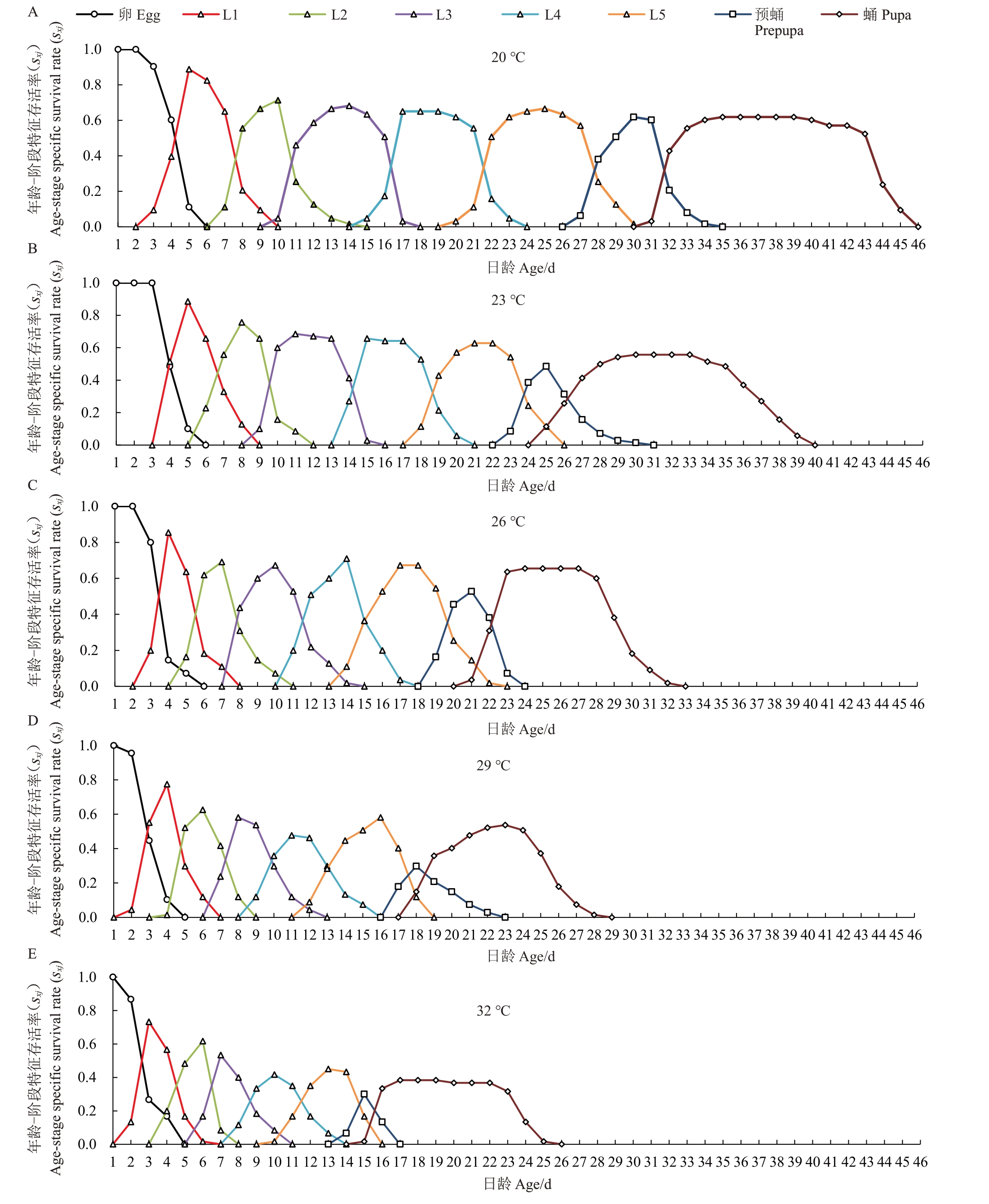
图1 不同温度下粗胫翠尺蛾的年龄-阶段特征存活率
Fig.1 Age-stage specific survival rate of T.immissaria at different temperatures
L1~L5 分别为1~5 龄幼虫。
L1-L5 represent 1st to 5th instar larva,respectively.
种群年龄-特征存活率(lx)的结果(图2)表明,粗胫翠尺蛾种群内个体死亡主要发生在后期,前期个体死亡趋于缓和。20 ℃和23 ℃处理的lx曲线在0~16 d 的坡度较平缓,16 d 之后存活率指数迅速下滑至0%;26 ℃处理的lx曲线在0~11 d 的坡度较平缓,11 d 之后存活率指数迅速下滑至0%;29 ℃和32 ℃处理的lx曲线在0~6 d 的坡度较平缓,6 d 后存活率指数迅速下滑至0%。雌虫年龄-特征繁殖力(fxj)和种群年龄-特征繁殖力(mx)曲线(图2)表明,5个温度下fxj 和mx 最高峰依次为26 ℃>29 ℃>23 ℃>20 ℃>32 ℃(fxj 最大值分别为58.7、57.0、51.0、45.7、38.0;mx 最 大 值 分 别 为37.33、28.71、27.69、26.10、13.16),20~26 ℃温度下粗胫翠尺蛾雌成虫的羽化和产卵相对较为分散,导致繁殖力曲线忽高忽低。种群年龄-特征净增殖率(lxmx)曲线(图2)表 明,5 个 温 度 下lxmx 最 高 峰 依 次 为26 ℃>23 ℃>29 ℃>20 ℃>32 ℃。

图2 不同温度下粗胫翠尺蛾种群年龄-特征存活率及繁殖力
Fig.2 Age-specific survival rate and fecundity of T.immissaria at different temperatures
lx.种群年龄-特征存活率;fxj.雌虫年龄-特征繁殖力;mx.种群年龄-特征繁殖力;lxmx.种群年龄-特征净增殖率。
lx. Indicates age-specific survival rate; fxj.Indicates age-specific fecundity of female; mx.Indicates age-specific fecundity of population; lxmx.Indicates age-specific net reproductive rate of population.
2.3 不同温度条件下粗胫翠尺蛾种群生命表参数
如表3 所示,粗胫翠尺蛾种群在26、29 ℃处理下的内禀增长率(r)和周限增长率(λ)均相对较高,且显著高于20 ℃处理(p<0.05)。26 ℃处理下的净增殖率(R0)为176.92±8.52,显著高于其他温度处理(p<0.05)。平均世代周期T表现出随着温度的升高而逐渐降低的趋势,20 ℃处理的平均世代周期为(65.05±6.41)d,显著高于26、29、32 ℃处理[分别为(47.15±4.10)、(39.22±4.07)、(34.79±3.91)d](p<0.05)。此外,20 ℃处理的种群倍增时间Dt也最长,为(9.13±0.90)d,显著高于26、29、32 ℃处理(p<0.05)。
表3 不同温度下粗胫翠尺蛾实验种群生命表参数
Table 3 Life table parameter of T.immissaria at different temperatures

温度Temperature/℃20 23 26 29 32内禀增长率(r)Inrtinsic rate of increase 0.08±0.01 c 0.08±0.01 bc 0.11±0.01 ab 0.12±0.01 a 0.10±0.01 abc周限增长率(λ)Finite rate of increase 1.08±0.01 c 1.09±0.01 bc 1.12±0.01 ab 1.13±0.01 a 1.11±0.01 abc净繁殖率(R0)Net reproductive rate 139.63±7.69 b 142.09±10.38 b 176.92±8.52 a 107.01±9.11 c 45.57±5.21 d平均世代周期(T)Mean generation time/d 65.05±6.41 a 59.54±4.11 ab 47.15±4.10 bc 39.22±4.07 c 34.79±3.91 c种群倍增时间(Dt)Population doubling time/d 9.13±0.90 a 8.33±0.58 ab 6.31±0.55 bc 5.82±0.61 c 6.31±0.76 bc
2.4 粗胫翠尺蛾不同虫态发育速率与温度的关系
相关分析结果表明,粗胫翠尺蛾卵、各龄幼虫、预蛹和蛹的发育速率与温度均呈显著相关(p<0.05 或p<0.01),在20~32 ℃温度范围内各虫态的发育速率均随着温度的升高而加快。二次回归模型的相关系数R2值均大于线性回归模型,表明在20~32 ℃范围内二次回归模型能更好地拟合两者的关系(表4,图3),该优势在卵、预蛹期和蛹期表现的最为突出。此外,预蛹的发育速率受温度的影响最为明显(图3-C),其次为卵期和蛹期(图3-A,D)。
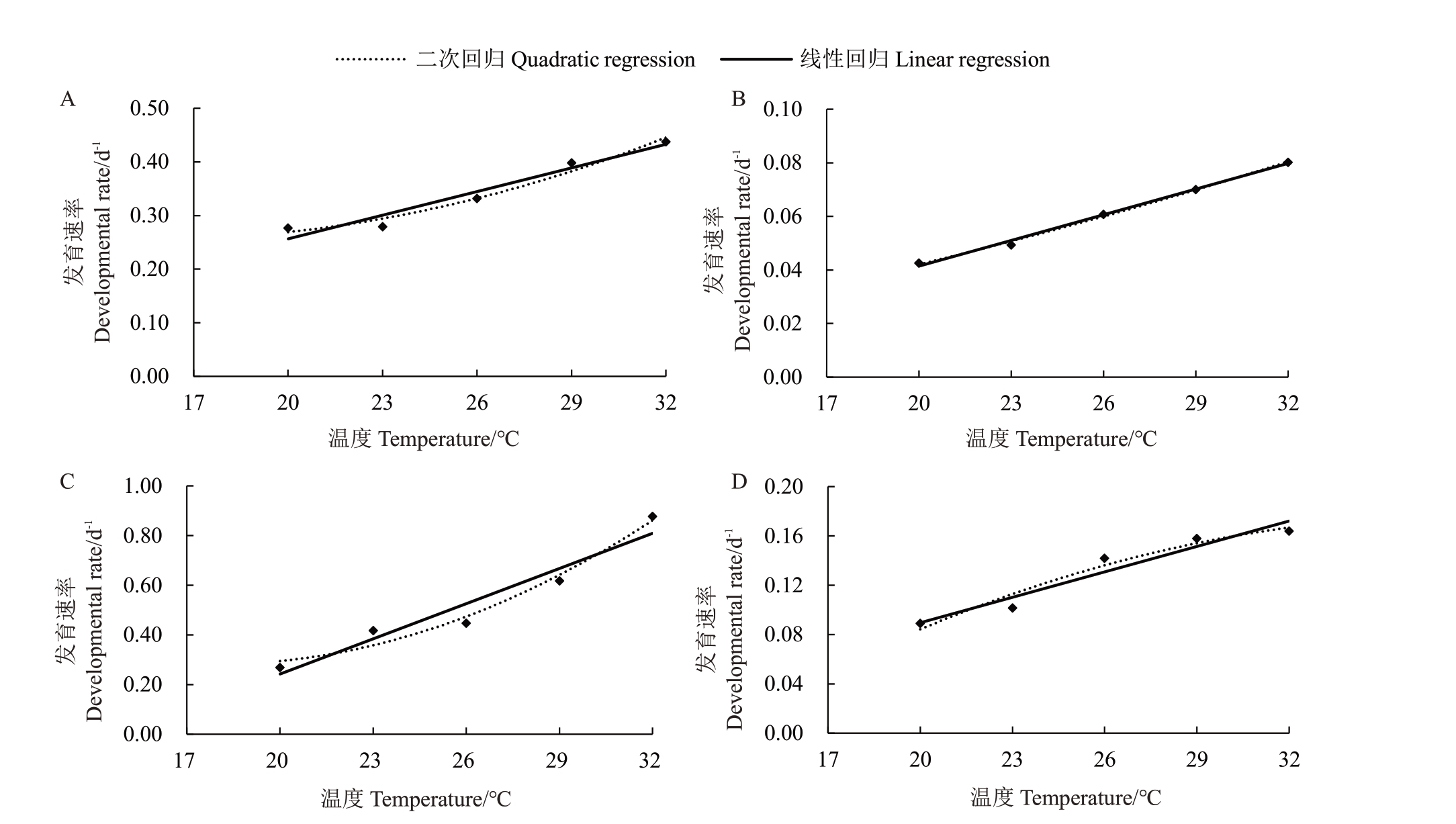
图3 粗胫翠尺蛾不同发育阶段发育速率与温度的关系
Fig.3 Relationship between temperature and developmental rate of T.immissaria at different developmental stages
A.卵;B.幼虫;C.预蛹;D.蛹。
A.Egg;B.Larva;C.Prepupa;D.Pupa.
表4 粗胫翠尺蛾不同虫态发育速率(V)与温度(T)的预测模型
Table 4 Forecast models based on the developmental rate(V)and temperature(T)in T.immissaria at different developmental stages
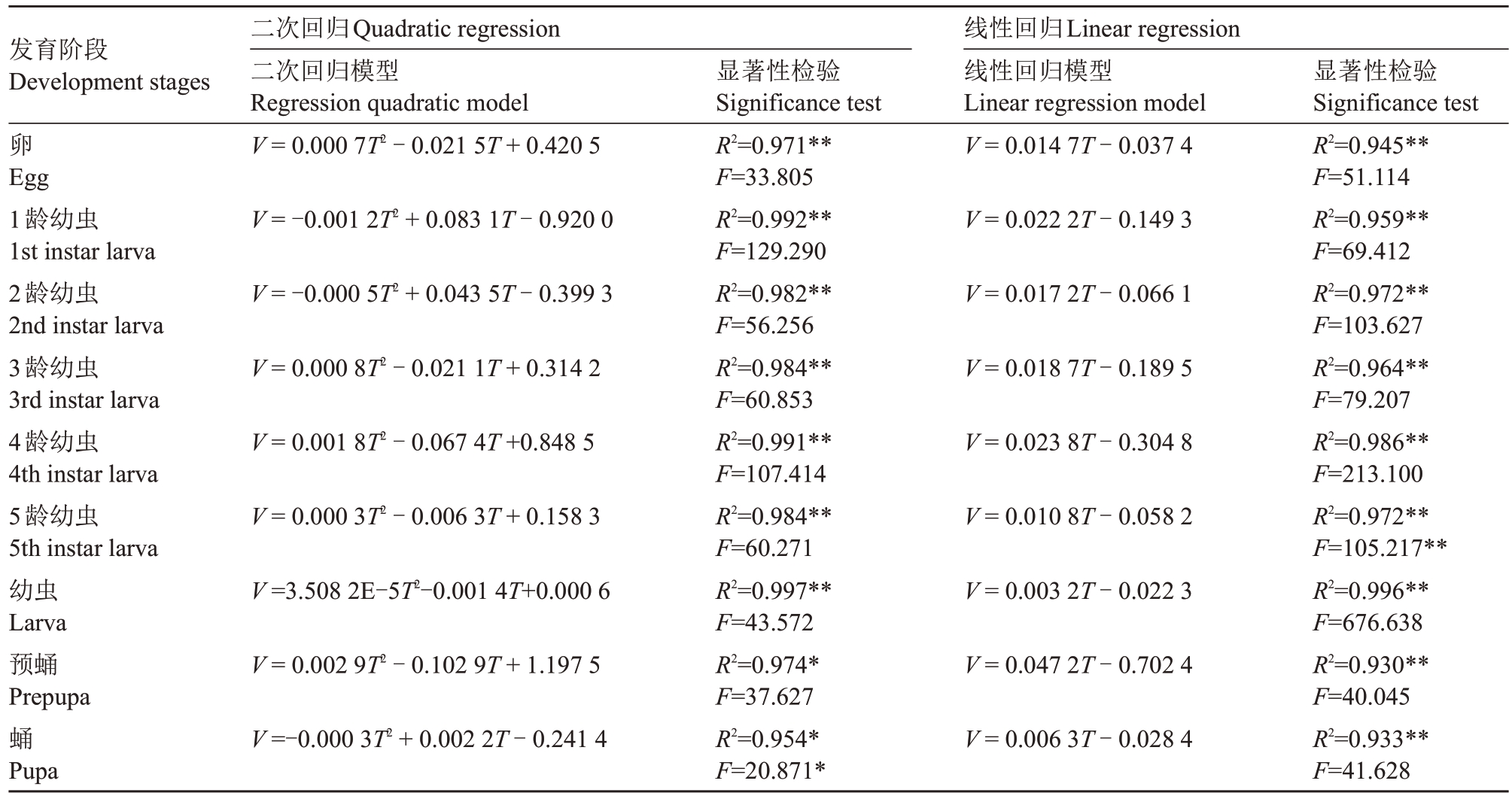
注:V.发育速率;T.环境温度。*、**分别表示温度与发育速率在p<0.05、p<0.01 水平显著相关。
Note:V.Developmental rate,T.Environmental temperature.*, **.Significant correlation between temperature and developmental rate at the p<0.05,p<0.01 level,respectively.
发育阶段Development stages 显著性检验Significance test R2=0.945**F=51.114 R2=0.959**F=69.412 R2=0.972**F=103.627 R2=0.964**F=79.207 R2=0.986**F=213.100 R2=0.972**F=105.217**R2=0.996**F=676.638 R2=0.930**F=40.045 R2=0.933**F=41.628卵二次回归Quadratic regression二次回归模型Regression quadratic model V=0.000 7T2-0.021 5T+0.420 5线性回归Linear regression线性回归模型Linear regression model V=0.014 7T-0.037 4 Egg 1龄幼虫1st instar larva 2龄幼虫2nd instar larva 3龄幼虫3rd instar larva 4龄幼虫4th instar larva 5龄幼虫5th instar larva幼虫Larva预蛹Prepupa蛹Pupa V=-0.001 2T2+0.083 1T-0.920 0 V=0.022 2T-0.149 3 V=-0.000 5T2+0.043 5T-0.399 3 V=0.017 2T-0.066 1 V=0.000 8T2-0.021 1T+0.314 2 V=0.018 7T-0.189 5 V=0.001 8T2-0.067 4T+0.848 5 V=0.023 8T-0.304 8 V=0.000 3T2-0.006 3T+0.158 3 V=0.010 8T-0.058 2 V=3.508 2E-5T2-0.001 4T+0.000 6 V=0.003 2T-0.022 3 V=0.002 9T2-0.102 9T+1.197 5 V=0.047 2T-0.702 4 V=-0.000 3T2+0.002 2T-0.241 4显著性检验Significance test R2=0.971**F=33.805 R2=0.992**F=129.290 R2=0.982**F=56.256 R2=0.984**F=60.853 R2=0.991**F=107.414 R2=0.984**F=60.271 R2=0.997**F=43.572 R2=0.974*F=37.627 R2=0.954*F=20.871*V=0.006 3T-0.028 4
2.5 荔枝粗胫翠尺蛾各虫态的发育起点温度和有效积温
粗胫翠尺蛾各虫态发育起点温度和有效积温存在一定差异,不同方法计算所得同一虫态的发育起点温度和有效积温亦不相同(表5)。根据2 种计算方法的变异系数,直线回归法有7个发育阶段的CV值小于直接最优法,故直线回归法更优。直线回归法计算结果显示,粗胫翠尺蛾发育起点温度以卵最低(3.84 ℃),其次为2龄幼虫(4.48 ℃),以预蛹的发育起点温度最高(15.65 ℃)。有效积温以预蛹最低(19.70 ℃·d),蛹最高(135.67 ℃·d)。粗胫翠尺蛾完成整个世代所需的有效积温为531.99 ℃·d;卵发育有效积温为64.30 ℃·d;整个幼虫期所需有效积温为311.56 ℃·d,占全世代所需有效积温的58.57%,其中1 龄幼虫发育有效积温最低(43.26 ℃·d),5 龄幼虫发育有效积温最高(90.15 ℃·d)(表5)。
表5 粗胫翠尺蛾不同虫态的发育起点温度和有效积温
Table 5 Developmental threshold temperature and effective accumulated temperature of T.immissaria at different stages
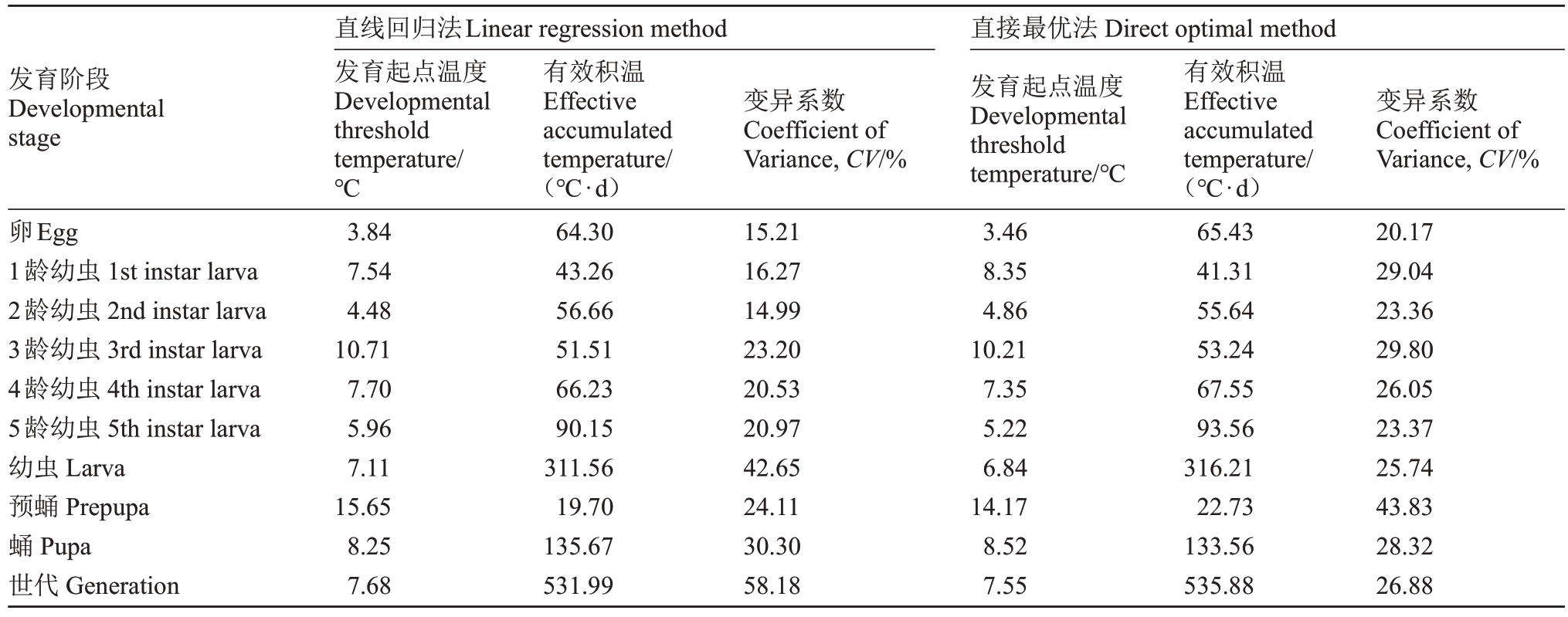
发育阶段Developmental stage变异系数Coefficient of Variance,CV/%变异系数Coefficient of Variance,CV/%卵Egg 1龄幼虫1st instar larva 2龄幼虫2nd instar larva 3龄幼虫3rd instar larva 4龄幼虫4th instar larva 5龄幼虫5th instar larva幼虫Larva预蛹Prepupa蛹Pupa世代Generation直线回归法Linear regression method发育起点温度Developmental threshold temperature/℃3.84 7.54 4.48 10.71 7.70 5.96 7.11 15.65 8.25 7.68有效积温Effective accumulated temperature/(℃·d)64.30 43.26 56.66 51.51 66.23 90.15 311.56 19.70 135.67 531.99 15.21 16.27 14.99 23.20 20.53 20.97 42.65 24.11 30.30 58.18直接最优法Direct optimal method发育起点温度Developmental threshold temperature/℃3.46 8.35 4.86 10.21 7.35 5.22 6.84 14.17 8.52 7.55有效积温Effective accumulated temperature/(℃·d)65.43 41.31 55.64 53.24 67.55 93.56 316.21 22.73 133.56 535.88 20.17 29.04 23.36 29.80 26.05 23.37 25.74 43.83 28.32 26.88
3 讨 论
昆虫作为变温动物,自身无恒定体温,因此环境温度的改变将直接影响昆虫生长、发育、繁殖和存活等,决定昆虫种群数量的动态变化[15]。温度对昆虫活动、分布和多度的影响最为显著,昆虫种群生活在适温区内才能维持正常发育与繁殖[16-17]。在自然环境下,在适合生长发育的温度范围内,昆虫随着温度的升高发育速率加快。前人研究发现,灰茶尺蠖(Ectropis grisescens Warren)[18]、大造桥虫(Ascotis selenaria)[19]、大蜡螟(Galleria mellonella)[20]和草地贪夜蛾(Spodoptera frugiperda)[7,21]的卵、幼虫、蛹的发育历期均随温度的升高而缩短,温度对上述4种鳞翅目昆虫各虫态的存活率、发育历期及繁殖力均有显著影响。然而,关于粗胫翠尺蛾对环境温度的适应性目前还尚未见相关报道。本研究结果表明,20~32 ℃内,粗胫翠尺蛾各虫态均能正常发育,发育历期随温度的升高而缩短;温度越高,则发育越快。该研究结果与徐盼等[22]和郝强等[23]学者的研究结果一致。
生命表是昆虫种群生态学研究的重要方法[24-25]。利用昆虫生命表分析获得的种群内禀增长率等生态学指标,对指导害虫防治具有十分重要的意义。传统生命表以雌性为主,忽略了雄性个体与龄期变化,无法精确描述昆虫的变态以及性比对种群增长的影响[24],而我国学者Chi 等[10]创立的年龄-阶段两性生命表则弥补了传统生命表的不足,充分考虑了昆虫种群的龄期分化以及雄性个体对种群的贡献,可以精确描述昆虫龄期分化,正确分析繁殖力,从而预测种群的增长。笔者在本研究中运用年龄-阶段两性生命表,分析了不同温度下粗胫翠尺蛾的种群动态以及主要种群参数,结果表明,粗胫翠尺蛾卵、幼虫和蛹的存活率随着温度的升高逐渐下降,32 ℃处理1 龄幼虫的存活率低于80%,而蛹的存活率低于40%。随着温度的升高,粗胫翠尺蛾的繁殖力也有一定的波动,32 ℃处理的单雌产卵量、雌虫年龄-特征繁殖力和种群年龄-特征繁殖力也均明显低于其他温度处理。不同昆虫对温度的耐受力不同,主要表现在存活率和繁殖力方面,高温或低温均不利于昆虫存活与繁殖[26]。本研究中结合不同温度下粗胫翠尺蛾各虫态的发育历期、成虫寿命等进行分析,32 ℃温度不利于粗胫翠尺蛾的发育,23~29 ℃温度较适合其种群发育。广东荔枝、龙眼产区每年5—7 月和9—11 月,气温恰好处在23~29 ℃范围内,且在全年这两个时期粗胫翠尺蛾发生危害相对较重,本研究结果与粗胫翠尺蛾实际发生情况相符[27]。
昆虫发育起点温度、有效积温及温度与昆虫生长发育模型可用于推算和预测昆虫完成生活史或某一虫态的发育历期及发生代数,进而确定防治害虫的时间及次数[20]。本研究结果表明,二次回归模型能更好地反映粗胫翠尺蛾各虫态的发育速率与温度的关系,应优先使用二次回归模型对其各虫态的发育速率进行预测。粗胫翠尺蛾1~2龄幼虫个体较小,3龄以上个体增大,食量大增,危害力增强。因此,可根据模型预测幼虫的发育期,准确把握最佳防治期。本研究中粗胫翠尺蛾卵和2龄幼虫的发育起点温度较低,分别为3.84 ℃和4.48 ℃,表明该虫卵和2 龄幼虫对低温适应能力相对较强;预蛹发育起点温度为15.65 ℃,高于其他各虫态,该结果很好地解释了粗胫翠尺蛾在冬季无法化蛹并以幼虫越冬的原因。
本研究是在特定恒温恒湿的人工气候箱内进行的,与自然条件存在一定的差异,且笔者在本研究中仅研究了温度对荔枝粗胫翠尺蛾生长发育的影响,而寄主种类、光周期、湿度等其他因子也会影响昆虫的生长发育和繁殖[28-30]。因此,在进行害虫田间预测预报时,如何综合考虑各种外界因素对粗胫翠尺蛾生长发育和繁殖的联合作用以达到精准防控,尚需深入研究。
4 结 论
温度对荔枝粗胫翠尺蛾的生长发育和繁殖具有明显的影响。粗胫翠尺蛾在26~29 ℃温度条件下种群增长能力相对较强,23~29 ℃是粗胫翠尺蛾生长发育和繁殖的最适温度范围。研究结果将为荔枝粗胫翠尺蛾的田间预测预报及综合防控提供理论依据。
[1]陈炳旭,董易之,陈刘生,陆恒,成家宁,王安勇,王敏.荔枝粗胫翠尺蛾的鉴定及生物学特性研究[J].果树学报,2010,27(2):261-264.CHEN Bingxu,DONG Yizhi,CHEN Liusheng,LU Heng,CHENG Jianing,WANG Anyong,WANG Min.Identification and biological characteristics of Thalassodes immissaria,an emerald moth infesting litchi[J].Journal of Fruit Science,2010,27(2):261-264.
[2]成家宁,陈炳旭,曾鑫年,董易之,陆恒,徐淑.14 种植物乙醇提取物对荔枝粗胫翠尺蛾成虫产卵和幼虫取食的影响[J].果树学报,2011,28(2):290-295.CHENG Jianing,CHEN Bingxu,ZENG Xinnian,DONG Yizhi,LU Heng,XU Shu.Effects of ethanol extracts from 14 plant species on oviposition and feeding behavior of Thalassodes immissaria Walker (Lepidoptera:Geometridae)[J].Journal of Fruit Science,2011,28(2):290-295.
[3]成家宁,陈炳旭,曾鑫年,李鹏燕,董易之,徐淑.荔枝粗胫翠尺蛾触角感器的扫描电镜观察[J].中国南方果树,2012,41(4):28-32.CHENG Jianing,CHEN Bingxu,ZENG Xinnian,LI Pengyan,DONG Yizhi,XU Shu.Observation on antenna sensilla of Thalassodes immissaria Walker with a scanning electron microscope[J].South China Fruits,2012,41(4):28-32.
[4]李鹏燕,成家宁,陈炳旭,曾鑫年,董易之,徐淑.粗胫翠尺蛾对不同荔枝品种的选择性研究[J].果树学报,2012,29(3):434-439.LI Pengyan,CHENG Jianing,CHEN Bingxu,ZENG Xinnian,DONG Yizhi,XU Shu.Study on the selectivity of Thalassodes immissaria (Lepidoptera:Geometridae) to litchi varieties[J].Journal of Fruit Science,2012,29(3):434-439.
[5]姚琼,全林发,徐淑,董易之,李文景,池艳艳,陈炳旭.粗胫翠尺蛾视蛋白基因的克隆及灯光对其表达量的影响[J].中国农学通报,2022,38(16):103-109.YAO Qiong,QUAN Linfa,XU Shu,DONG Yizhi,LI Wenjing,CHI Yanyan,CHEN Bingxu.Identification and characterization of opsin genes from Thalassodes immissaria and gene expression after white LED treatment[J].Chinese Agricultural Science Bulletin,2022,38(16):103-109.
[6]蔡普默,赵梦婷,宋蕴哲,孟李涛,季清娥,林嘉,李焰焰,聂传朋.基于历史数据探究气候变暖对我国瓜实蝇物候的影响[J].中国瓜菜,2022,35(9):64-72.CAI Pumo,ZHAO Mengting,SONG Yunzhe,MENG Litao,JI Qing’e,LIN Jia,LI Yanyan,NIE Chuanpeng.Investigating the impacts of climatic warming on phenology of Zeugodacus cucurbitae (Diptera:Tephritidae) in China based on historical data[J].China Cucurbits and Vegetables,2022,35(9):64-72.
[7]何莉梅,葛世帅,陈玉超,吴秋琳,姜玉英,吴孔明.草地贪夜蛾的发育起点温度、有效积温和发育历期预测模型[J].植物保护,2019,45(5):18-26.HE Limei,GE Shishuai,CHEN Yuchao,WU Qiulin,JIANG Yuying,WU Kongming.The developmental threshold temperature,effective accumulated temperature and prediction model of developmental duration of fall armyworm,Spodoptera frugiperda[J].Plant Protection,2019,45(5):18-26.
[8]时培建,池本孝哉,戈峰.温度与昆虫生长发育关系模型的发展与应用[J].应用昆虫学报,2011,48(5):1149-1160.SHI Peijian,IKEMOTO Takaya,GE Feng.Development and application of models for describing the effects of temperature on insects’growth and development[J].Chinese Journal of Applied Entomology,2011,48(5):1149-1160.
[9]BARTEKOVÁ A,PRASLIČKA J.The effect of ambient temperature on the development of cotton bollworm(Helicoverpa armigera Hübner,1808)[J].Plant Protection Science,2006,42(4):135-138.
[10]CHI H,LIU H.Two new methods for the study of insect population ecology[J].Bulletin of the Institute of Zoology,Academia Sinica,1985,24(2):225-240.
[11]葛繁星,史凡,程春喜,陈李林.两性生命表研究灰茶尺蠖与茶尺蠖生长发育和繁殖力[J].茶叶科学,2022,42(6):828-838.GE Fanxing,SHI Fan,CHENG Chunxi,CHEN Lilin.Development and reproduction of Ectropis grisescens and Ectropis obliqua based on the two-sex life table[J].Journal of Tea Science,2022,42(6):828-838.
[12]桂华敏,夏涛,王思洁,吴国星,张祖兵,朱国渊,张永科,高熹.温度对辣木瑙螟生长发育和繁殖的影响[J].南方农业学报,2021,52(12):3400-3407.GUI Huamin,XIA Tao,WANG Sijie,WU Guoxing,ZHANG Zubing,ZHU Guoyuan,ZHANG Yongke,GAO Xi.Effects of temperature on the growth,development and reproduction of Noorda blitealis Walker[J].Journal of Southern Agriculture,2021,52(12):3400-3407.
[13]姚洁,戴仁怀,代传勇,杨洪.温度对菜豆象发育和繁殖的影响[J].昆虫学报,2016,59(7):739-746.YAO Jie,DAI Renhuai,DAI Chuanyong,YANG Hong.Effects of temperature on the development and reproduction of Acanthoscelides obtectus (Coleoptera:Bruchidae)[J].Acta Entomologica Sinica,2016,59(7):739-746.
[14]李典谟,王莽莽.快速估计发育起点及有效积温法的研究[J].昆虫知识,1986,23(4):184-187.LI Dianmo,WANG Mangmang.Study on the rapid estimation method of developmental threshold temperature and effective accumulated temperature[J].Entomological Knowledge,1986,23(4):184-187.
[15]CUI J,ZHU S Y,BI R,XU W,GAO Y,SHI S S.Effect of temperature on the development,survival,and fecundity of Heliothis viriplaca (Lepidoptera:Noctuidae)[J].Journal of Economic Entomology,2018,111(4):1940-1946.
[16]刘安然.温度对昆虫繁殖力的影响及其机制初探[J].江西农业,2020(6):105.LIU Anran.Effects and mechanism of temperature on the fertility of insect[J].Jiangxi Agriculture,2020(6):105.
[17]BAI Y L,QUAIS M K,ZHOU W W,ZHU Z R.Consequences of elevated temperature on the biology,predation,and competitiveness of two mirid predators in the rice ecosystem[J].Journal of Pest Science,2022,95(2):901-916.
[18]葛超美,殷坤山,唐美君,肖强.灰茶尺蠖发育起点温度和有效积温的研究[J].植物保护,2016,42(6):110-112.GE Chaomei,YIN Kunshan,TANG Meijun,XIAO Qiang.Developmental threshold temperature and effective accumulated temperature of Ectropis grisescens[J].Plant Protection,2016,42(6):110-112.
[19]史树森,崔娟,徐伟,张青玲,朱诗禹.温度对大造桥虫生长发育和繁殖的影响[J].中国油料作物学报,2015,37(5):707-712.SHI Shusen,CUI Juan,XU Wei,ZHANG Qingling,ZHU Shiyu.Effects of temperature on development and reproduction of Ascotis selenaria[J].Chinese Journal of Oil Crop Sciences,2015,37(5):707-712.
[20]罗丽林,杨广明,龙立炎,王兴红,黄振兴,乙天慈,罗雪丹,刘曼.温度对大蜡螟生长发育和繁殖的影响[J].植物保护学报,2022,49(2):644-653.LUO Lilin,YANG Guangming,LONG Liyan,WANG Xinghong,HUANG Zhenxing,YI Tianci,LUO Xuedan,LIU Man.Effects of temperature on the development and reproduction of the greater wax moth,Galleria mellonella[J].Journal of Plant Protection,2022,49(2):644-653.
[21]鲁智慧,和淑琪,严乃胜,赵文杰,姚万福,陈亚平,杨通,姜玉英,桂富荣.温度对草地贪夜蛾生长发育及繁殖的影响[J].植物保护,2019,45(5):27-31.LU Zhihui,HE Shuqi,YAN Naisheng,ZHAO Wenjie,YAO Wanfu,CHEN Yaping,YANG Tong,JIANG Yuying,GUI Furong.Effects of temperatures on the development and reproduction of fall armyworm (Spodoptera frugiperda Smith)[J].Plant Protection,2019,45(5):27-31.
[22]徐盼,徐志宏,李绍进,许渭根,李罕琼,盛仙俏,金文灶,王莹莹,赵亦曼.不同温度下康氏粉蚧实验种群生命表[J].昆虫学报,2012,55(12):1362-1367.XU Pan,XU Zhihong,LI Shaojin,XU Weigen,LI Hanqiong,SHENG Xianqiao,JIN Wenzao,WANG Yingying,ZHAO Yiman.Life table of the experimental population of comstock mealybug,Pseudococcus comstocki (Hemiptera:Pseudococcidae),at different temperatures[J].Acta Entomologica Sinica,2012,55(12):1362-1367.
[23]郝强,黄倩,梁炜博,贡常委,王学贵.不同温度下斜纹夜蛾的两性生命表[J].昆虫学报,2016,59(6):654-662.HAO Qiang,HUANG Qian,LIANG Weibo,GONG Changwei,WANG Xuegui.Age-stage two-sex life tables of Spodoptera litura (Lepidoptera:Noctuidae) at different temperatures[J].Acta Entomologica Sinica,2016,59(6):654-662.
[24]齐心,傅建炜,尤民生.年龄-龄期两性生命表及其在种群生态学与害虫综合治理中的应用[J].昆虫学报,2019,62(2):255-262.QI Xin,FU Jianwei,YOU Minsheng.Age-stage,two-sex life table and its application in population ecology and integrated pest management[J].Acta Entomologica Sinica,2019,62(2):255-262.
[25]王自杰,李丽霞,李小花,李文博,高宇,李进步,史树森.不同浓度噻虫嗪对点蜂缘蝽种群的跨代效应[J].昆虫学报,2023,66(3):312-325.WANG Zijie,LI Lixia,LI Xiaohua,LI Wenbo,GAO Yu,LI Jinbu,SHI Shusen.Cross-generational effects of different concentrations of thiamethoxam on Riptortus pedestris (Hemiptera:Alydidae) populations[J].Acta Entomologica Sinica,2023,66(3):312-325.
[26]徐川峰,骆丹,殷立新,刘兴平.温度对樟叶蜂生长发育和繁殖的影响[J].昆虫学报,2017,60(10):1216-1225.XU Chuanfeng,LUO Dan,YIN Lixin,LIU Xingping.Influence of temperature on the development and reproduction of the camphor sawfly,Mesoneura rufonota (Hymenoptera:Tenthredinidae)[J].Acta Entomologica Sinica,2017,60(10):1216-1225.
[27]陈炳旭.荔枝龙眼病虫害绿色防控彩色图谱[M].北京:中国农业出版社,2020:36.CHEN Bingxu.Color book of non-pollution control technique for diseases and pests of litchi and longan[M].Beijing:China Agriculture Press,2020:36.
[28]苏湘宁,李传瑛,黄少华,刘伟玲,章玉苹,潘志萍.草地贪夜蛾人工饲料及饲养条件的优化[J].环境昆虫学报,2019,41(5):992-998.SU Xiangning,LI Chuanying,HUANG Shaohua,LIU Weiling,ZHANG Yuping,PAN Zhiping.Optimization of artificial diet and rearing condition of fall armyworm,Spodoptera frugiperda(J.E.Smith)[J].Journal of Environmental Entomology,2019,41(5):992-998.
[29]戴钎萱,李子园,田耀加,张振飞,王磊,陆永跃,李有志,陈科伟.不同品种玉米对草地贪夜蛾生长发育及繁殖的影响[J].应用生态学报,2020,31(10):3273-3281.DAI Qianxuan,LI Ziyuan,TIAN Yaojia,ZHANG Zhenfei,WANG Lei,LU Yongyue,LI Youzhi,CHEN Kewei.Effects of different corn varieties on development and reproduction of Spodoptera frugiperda[J].Chinese Journal of Applied Ecology,2020,31(10):3273-3281.
[30]MIKI T,SHINOHARA T,CHAFINO S,NOJI S,TOMIOKA K.Photoperiod and temperature separately regulate nymphal development through JH and insulin/TOR signaling pathways in an insect[J].Proceedings of the National Academy of Sciences of the United States of America,2020,117(10):5525-5531.